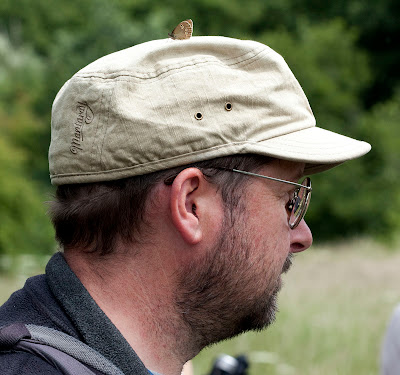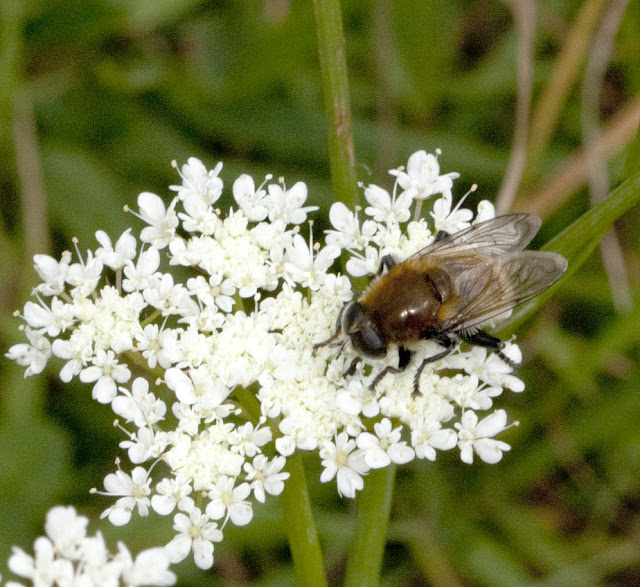 |
| Red-tailed bumblebee, Bombus lapidarius, feeding on white clover, Trifolium repens. Jubilee Country Park, 19 June 2011. |
This walk was designed to show us some of the park's bumblebees, and teach us about them at the same time. Jenny Price of BCS led. She used the common names of bumblebees, which I found confusing, as I did not know any of them, only the Linnaean names. But it sounded more friendly for the inexperienced members of the group. There were about 20 in the group, including three young children who were particularly enthusiastic and able to identify many invertebrates.
It can be hard to identify bumblebees. Some species look alike; the males, females and queens of one species can look quite different from each other; and to add interest, some other insects look a lot like them. But there are not many that you are likely to see. Of the 22 species of British bumblebees, only six are common, and we didn't see all of those on this day.
 |
| Caterpillar of six-spot burnet moth, Zygaena filipendulae, on bird's-foot trefoil, Lotus corniculatus. Jubilee Country Park, 19 June 2011. |
There were plenty of other insects to give us pleasure. Quite soon one of the group spotted some caterpillars and pupa cases of the six-spot burnet moth. Both six-spot and five-spot burnets were flying around, there were plenty of meadow brown butterflies, and later on a ringlet rested for a while on a walker's hat. I photographed a pair of small skippers that had been circling each other tightly in flight, sometimes resting for few seconds.
There were several flower beetles, including the bright iridescent green Oedemera nobilis and its smaller, browner relative Oedemera lurida. Once, as I was sitting in a meadow, a soldier beetle flew up and landed next to me, posing helpfully. It was Cantharis nigra (not pellucida as I had thought at first). There were also a few seven-spot ladybirds around.
I saw three species of hoverfly. A marmalade hoverfly, Episyrphus balteatus; one I haven't identified; and a Merodon equestris, one of the bumblebee imitators. Another of the imitators is in an earlier post here: Bumblebee and Hoverfly.
So what about the bumblebees? Quite a few were found when the sun came out. Most were the red-tailed, Bombus lapidarius, which seemed to prefer the white clover which was widespread in the areas with short grass and stunted dropwort. We looked for a species that likes woodland, Bombus hypnorum, but found only one possible specimen, which Jenny thought might be a cuckoo bumblebee. But it was an old individual, partly bald, so I am not sure.
 |
| Ringlet butterfly, Aphantopus hyperantus, on a walker's hat. Jubilee Country Park, 19 June 2011. |
Cuckoo bumblebees take over the nests of normal bees, evict the queen and fool the workers into rearing their own young; they look very much like the species they parasitise, so identification in the field is tricky.
To examine the live bees, they were put into a tube in which a soft plunger pushed the bees up against a mesh. It looked awkward, but didn't harm the bees, which flew off afterwards. I am including a photo of a white-tailed bumblebee, Bombus lucorum, in this temporary restraint.
The photo of the group in the meadow was taken with my Ixus 100; all the others were taken with my Canon EOS 450D with the 100mm macro lens.
 |
| Jenny Price leading the group into a meadow. Jubilee Country Park, 19 June 2011. |
 |
| White-tailed bumblebee, Bombus lucorum, temporarily immobilised for examination. Jubilee Country Park, 19 June 2011. |
 |
| The vivid underside of a six-spot burnet moth, Zygaena filipendulae. Jubilee Country Park, 19 June 2011. |
 |
| Hoverfly, Merodon equestris, a bumblebee imitator, on corky-fruited water dropwort, Oenanthe pimpinelloides. Jubilee Country Park, 19 June 2011. |
 |
| A soldier beetle, Cantharis nigra. Jubilee Country Park, 19 June 2011. |
 |
| An Essex Skipper, Thymelicus lineola, above, and a Small Skipper, Thymelicus sylvestris, below. Jubilee Country Park, 19 June 2011. |
No comments:
Post a Comment